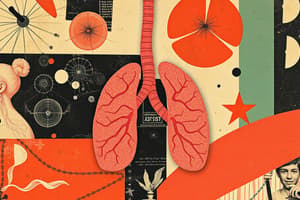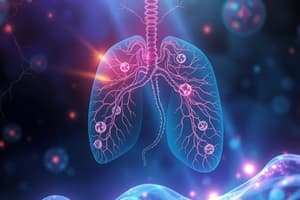Podcast
Questions and Answers
What is anabolic metabolism primarily responsible for?
What is anabolic metabolism primarily responsible for?
- Converting glucose into lactic acid
- Synthesizing complex molecules from simpler ones (correct)
- Breaking down complex molecules into simpler ones
- Releasing energy for cellular processes
Which of the following correctly describes the Krebs Cycle?
Which of the following correctly describes the Krebs Cycle?
- It occurs in the cytoplasm and produces ATP directly
- It operates without any electron carriers
- It generates glucose and oxygen as end products
- It involves the breakdown of pyruvate and releases CO2 (correct)
What is a key product of photosynthesis?
What is a key product of photosynthesis?
- Carbon dioxide
- Adrenaline
- Glucose (correct)
- Oxygen (correct)
What role do negative feedback mechanisms play in homeostasis?
What role do negative feedback mechanisms play in homeostasis?
Which stage of cellular respiration yields the most ATP?
Which stage of cellular respiration yields the most ATP?
In photosynthesis, the light-dependent reactions take place in which part of the cell?
In photosynthesis, the light-dependent reactions take place in which part of the cell?
What distinguishes aerobic cellular respiration from anaerobic respiration?
What distinguishes aerobic cellular respiration from anaerobic respiration?
Which of the following is NOT a result of metabolic processes?
Which of the following is NOT a result of metabolic processes?
Flashcards are hidden until you start studying
Study Notes
Life Processes in Biology
Metabolism
- Definition: All biochemical reactions occurring in organisms to maintain life.
- Types:
- Anabolism: Synthesis of complex molecules from simpler ones, requiring energy (e.g., protein synthesis).
- Catabolism: Breakdown of complex molecules into simpler ones, releasing energy (e.g., cellular respiration).
- Importance: Provides energy and building blocks for growth, maintenance, and repair.
Cellular Respiration
- Definition: Process by which cells convert glucose and oxygen into energy (ATP), carbon dioxide, and water.
- Stages:
- Glycolysis: Occurs in the cytoplasm; glucose is split into pyruvate, producing small amounts of ATP.
- Krebs Cycle: Occurs in the mitochondria; pyruvate is further broken down, releasing CO2 and transferring energy to electron carriers.
- Electron Transport Chain: Occurs in the inner mitochondrial membrane; uses electron carriers to generate large amounts of ATP through oxidative phosphorylation.
- Types:
- Aerobic: Requires oxygen; produces more ATP.
- Anaerobic: Occurs without oxygen; produces less ATP (e.g., lactic acid fermentation).
Photosynthesis
- Definition: Process by which green plants, algae, and some bacteria convert light energy into chemical energy (glucose).
- Equation: 6CO2 + 6H2O + light energy → C6H12O6 + 6O2.
- Stages:
- Light-dependent Reactions: Occur in the thylakoid membranes; convert light energy into chemical energy (ATP and NADPH).
- Calvin Cycle (Light-independent Reactions): Occurs in the stroma; uses ATP and NADPH to convert CO2 into glucose.
- Importance: Provides oxygen and is the foundation of the food chain.
Homeostasis
- Definition: The process by which organisms maintain a stable internal environment despite external changes.
- Mechanisms:
- Feedback Loops:
- Negative Feedback: Reduces the effect of a change (e.g., body temperature regulation).
- Positive Feedback: Enhances the effect of a change (e.g., blood clotting).
- Regulatory Systems: Involves sensors, control centers, and effectors (e.g., endocrine and nervous systems).
- Feedback Loops:
- Examples: Temperature regulation, pH balance, hydration levels.
Reproduction
- Definition: Biological process by which new individual organisms are produced.
- Types:
- Asexual Reproduction: Involves a single parent; offspring are genetically identical (e.g., binary fission, budding).
- Sexual Reproduction: Involves two parents; offspring have genetic variation (e.g., fertilization).
- Importance: Ensures species survival, genetic diversity, and adaptation to changing environments.
Metabolism
- All biochemical reactions in organisms essential for sustaining life.
- Anabolism: Energy-consuming processes that synthesize complex molecules, e.g., protein synthesis.
- Catabolism: Energy-releasing processes that break down complex molecules, e.g., cellular respiration.
- Crucial for providing energy and building blocks necessary for growth, maintenance, and repair.
Cellular Respiration
- Converts glucose and oxygen to energy (ATP), carbon dioxide, and water.
- Glycolysis: Takes place in the cytoplasm, splitting glucose into pyruvate and yielding small amounts of ATP.
- Krebs Cycle: Located in the mitochondria, further breaks down pyruvate, releasing CO2 and generating energy for electron carriers.
- Electron Transport Chain: Happens in the inner mitochondrial membrane, produces a significant amount of ATP through oxidative phosphorylation.
- Distinct types include Aerobic respiration (requires oxygen, produces more ATP) and Anaerobic respiration (occurs without oxygen, produces less ATP, e.g., lactic acid fermentation).
Photosynthesis
- Process that converts light energy into chemical energy (glucose) by green plants, algae, and some bacteria.
- Chemical equation: 6CO2 + 6H2O + light energy → C6H12O6 + 6O2.
- Light-dependent Reactions: Occur in thylakoid membranes; transform light energy into ATP and NADPH.
- Calvin Cycle (Light-independent Reactions): Takes place in the stroma, uses ATP and NADPH to convert CO2 into glucose.
- Vital for oxygen production and serves as the basis of the food chain.
Homeostasis
- Maintains a stable internal environment despite external fluctuations.
- Feedback Loops:
- Negative Feedback: Counteracts changes to restore balance, e.g., thermoregulation.
- Positive Feedback: Amplifies changes to promote a specific outcome, e.g., blood clotting mechanisms.
- Involves regulatory systems with sensors, control centers, and effectors, such as the endocrine and nervous systems.
- Examples include body temperature regulation, pH balance, and maintaining hydration levels.
Reproduction
- Biological mechanism for producing new individual organisms.
- Asexual Reproduction: Involves one parent resulting in genetically identical offspring, such as binary fission and budding.
- Sexual Reproduction: Involves two parents leading to genetic variation in offspring, such as fertilization.
- Essential for species continuity, genetic diversity, and adaptability to environmental changes.
Studying That Suits You
Use AI to generate personalized quizzes and flashcards to suit your learning preferences.




